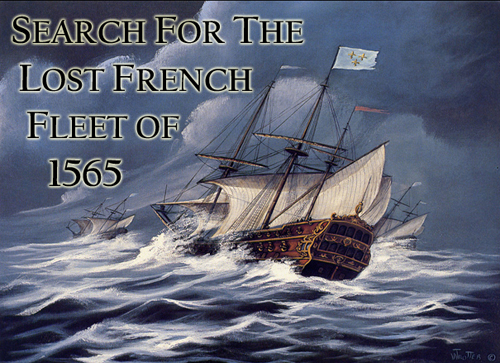
Today was an exciting day. At 10am we hosted a press conference to announce to the world that we will be launching an expedition to search for the lost French fleet of Jean Ribault, wrecked in 1565. This project is funded by the State of Florida and NOAA’s Office of Ocean Exploration, and is being carried out in partnership with the National Park Service, the Center for Historical Archaeology, and the Institute of Maritime History.
The story has been making a big splash in the news. Two Jacksonville TV stations, First Coast News and News4Jax (Channel 4) broadcast stories, and it was carried by the Jacksonville and St. Augustine papers.
From the Florida Times-Union by Matt Soergel:
ST. AUGUSTINE | A team of archaeologists unveiled plans Thursday for an oceangoing expedition to find the lost French fleet of Jean Ribault, which sank 449 years ago in a history-changing hurricane off Florida’s Atlantic coast…
Finding the fleet would be momentous, said Chuck Meide, the expedition’s principal investigator.
“It is Florida’s origin story, so it is also the story of the birth of our nation,” he said at a press conference under the live oaks outside the St. Augustine Lighthouse & Museum.
Meide, 43, a maritime archaeologist with the Lighthouse Archeological Maritime Program, will lead a crew of four on the search, which begins this month.
They’ll spend up to six days at a time on a converted shrimp boat, using sonar to look above the seabed and a magnetometer to search for metal — cannons, cannonballs and other artifacts — under the sand.
Ribault led a fleet of seven ships to the New World in 1565 to support the struggling new Huguenot French colony of Fort Caroline, in what is now Jacksonville. That colony alarmed and angered the Spanish, who quickly founded St. Augustine just down the coast to prepare for an attack on the French.
The French tried to strike first as Ribault sailed his four largest ships to make battle in St. Augustine. His plan turned disastrous as a hurricane pushed his fleet even farther south, scattering it and then wrecking it.
“It was a storm that literally changed American history,” Meide said.
With Ribault out of the picture, Fort Caroline was vulnerable to an overland attack by the Spanish, who marched through the wind and rain and wiped out the colony.
Meanwhile, Ribault and other shipwreck survivors, bedraggled and likely thirsty and hungry, trekked north back along the beach toward Fort Caroline, whose fate they could not have known.
But they could go no further when got stuck at the inlet later known as Matanzas — Spanish for “slaughter.”
It earned its name: The Spanish, led by Pedro Menendez de Aviles, twice marched from St. Augustine to wipe out separate groups of survivors, more than 200 men in all, including Ribault himself.
The doomed fleet’s location has been a mystery since.
Meide said the events were part of an epic clash between the Catholic Spanish, who had claimed the land for Spain, and the Protestant French settlers, whom they thought of as interlopers and heretics.“It’s a bloody story, but it’s our story,” said Meide, who quoted Mendendez on the conflict: “In his own words, ‘To fight them with blood and fire, to burn and hang the heretics.’ ”
A story was also run in the St. Augustine Record.

